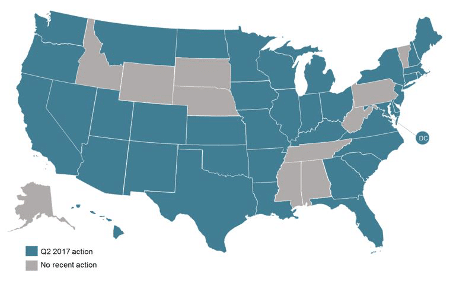The more things change, the more they stay the same. As documented in the latest quarterly edition of North Carolina Clean Energy Technology Center’s (NCCETC) 50 States of Solar report, utilities are still pushing for rates that would discourage customer adoption of solar, including increases in fixed and minimum charges, if not attempting to dismantle net metering directly.

NCCETC
Those two were the most popular actions in the Q2 Fifty States report, which showed 42 utility requests in 25 states to either increase fixed charges or minimum bills, and 24 states considering changes to net metering policies.
And, as documented in previous reports, utilities usually aren’t getting all that they want. Perhaps the most notable policy change during Q2 was Nevada doing a U-turn and implementing a new version of net metering. This policy is not as lucrative for distributed solar owners as the original, has still promises solar market revival and has brought back the big three residential solar companies to the state.
Meanwhile New Hampshire has also set a successor program to net metering, which follows in the footsteps of California by looking remarkably like the previous net metering policy. Such successor programs which do not represent fundamental changes are appearing to be more the rule than the exception, as pv magazine documented in our coverage of a panel discussion at the Intersolar North America trade show last week.
However, while net metering policies are in most places weathering utility assaults, another trend is moving beneath the surface, in that regulators more and more want to study the actual value that solar and other distributed energy resources provide to the grid.
“Many states are putting an emphasis on data-driven decision-making,” noted report lead author Autumn Proudlove, who serves as manager of policy research at NCCETC. “There are increasing efforts to conduct studies or pilot programs before making dramatic changes to net metering or rate design.”
All in all NCCETC found that 17 states and Washington D.C. studied either the value of distributed generation or net metering during Q2. And when such studies are conducted, they inevitably move in the direction of basing payment structures on the value provided, not a proxy of retail power.
“There seems to be a movement from net metering toward alternative compensation structures that are based on the value distributed energy resources provide to the grid,” said Achyut Shrestha, Senior Policy Analyst at NCCETC. “How these proceedings play out will have an important impact on state solar markets.”
This does not mean that the economics of behind-the-meter solar will dramatically change. Minnesota’s landmark Value of Solar proceeding has so far culminated in two utilities setting a value for distributed solar which is within one cent of retail rates on a per kilowatt-hour basis.
Meanwhile New York has finalized a formula valuing distributed energy as part of its Reforming the Energy Vision (REV) process, which is being widely watched across the nation. However, the state has temporarily kept compensation for small-scale distributed solar at the same level as net metering provided through a “market transition credit” for residential and small commercial installations.
It remains to be seen when value of solar/distributed energy resource policies fully replace retail-rate net metering as the norm for compensation of behind-the-meter generation. However, two things are unlikely to change: utility attempts to slow distributed solar, and regulators limiting the damage.
This content is protected by copyright and may not be reused. If you want to cooperate with us and would like to reuse some of our content, please contact: editors@pv-magazine.com.









By submitting this form you agree to pv magazine using your data for the purposes of publishing your comment.
Your personal data will only be disclosed or otherwise transmitted to third parties for the purposes of spam filtering or if this is necessary for technical maintenance of the website. Any other transfer to third parties will not take place unless this is justified on the basis of applicable data protection regulations or if pv magazine is legally obliged to do so.
You may revoke this consent at any time with effect for the future, in which case your personal data will be deleted immediately. Otherwise, your data will be deleted if pv magazine has processed your request or the purpose of data storage is fulfilled.
Further information on data privacy can be found in our Data Protection Policy.